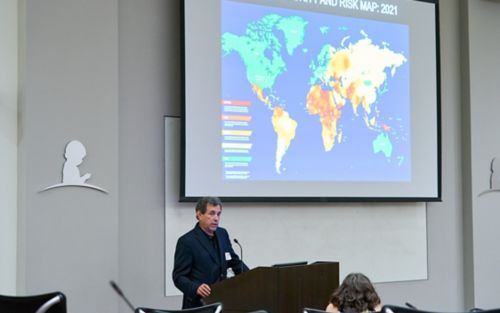St. Jude Family of Websites
Explore our cutting edge research, world-class patient care, career opportunities and more.
St. Jude Children's Research Hospital Home

- Fundraising
St. Jude Family of Websites
Explore our cutting edge research, world-class patient care, career opportunities and more.
St. Jude Children's Research Hospital Home

- Fundraising
SAFER Ukraine: a framework for responding to global conflicts

Paul Wise, MD, MPH, Stanford University, gave a guest lecture at St. Jude exploring how the SAFER Ukraine effort may hold lessons for responding to the shifting nature of global conflicts.
“The SAFER Ukraine program in many ways is on the leading edge of trying to address a trend that we've seen in global child health that has really accelerated over the past 15 years,” Paul Wise, MD, MPH, Stanford University, recently told an audience at St. Jude Children’s Research Hospital. “SAFER Ukraine is a recent evolving, emerging response to what, in fact, is a very dynamic set of challenges.”
Wise presented a guest lecture May 16 at St. Jude. His topic was, “Children in War: Assessing the Global Significance of SAFER Ukraine.” SAFER Ukraine is a humanitarian effort responding to the Russian invasion of Ukraine, which began in February. Through SAFER Ukraine, children with cancer have been evacuated from Ukraine and are continuing their cancer care elsewhere.
Wise provided an overview of the considerations needed to mount a response to a crisis abroad and discussed the changing landscape of global conflict. He also spoke about how SAFER Ukraine provides a framework for customizing medical responses to conflicts worldwide.
SAFER Ukraine helps children access cancer therapy
SAFER Ukraine is led by St. Jude Global alongside numerous partners including: doctors and nurses, researchers, hospitals, foundations, non-governmental organizations and governments. SAFER Ukraine created a registry to keep track of children whose medical records have been translated, and who have been evacuated or whose cases are being monitored. The registry currently includes more than 1,100 Ukrainian patients.
Wise is a senior advisor to SAFER Ukraine who offered guidance for the program’s structure and traveled to the program’s triage clinic in Poland. Wise’s research focuses on health inequalities, child health policy and global child health. He leads a multidisciplinary initiative called Children in Crisis, which integrates expertise in political science, security and health services in areas of civil conflict and unstable governance. Wise is also a mentor of Asya Agulnik, MD, MPH, St. Jude Global, who leads the SAFER Ukraine effort and trained at Stanford.
Conflicts around the world place children in jeopardy
Wise described the many considerations required to customize a response to war and violence. Conflicts can be intrastate or civil wars, which often last for years. Examples include the Syrian civil war which began in 2011. They can also be interstate, in which militaries of different countries go to war. Examples include Russia and Ukraine today. There are also non-war conflicts, which are marked by regional violence but no declaration of war. Examples include Caracas, Venezuela and Tijuana, Mexico.
“Some of the most dangerous places in the world for children, are not places that are at war,” Wise remarked.
Despite the nature of the conflict, civilians often suffer the direct and indirect effects of violence. These effects range from death and injury to infectious disease and food insecurity. Conflicts are also becoming more urban, with battles being fought street to street and house to house, Wise noted. How to provide medical care on the front lines of battles without taking sides is an increasing source of tension for non-governmental organizations attempting humanitarian responses.
“There's no consensus yet about how best to do this work,” Wise said. “Taking the SAFER Ukraine model and moving it to other conflict areas, requires special considerations to recognize what was unique about the situation that facilitated such a successful program in Ukraine that may not exist, or might even get you into big trouble in other types of settings.”
Lessons from SAFER Ukraine
SAFER Ukraine was established within days of the invasion by Russian forces. The program leveraged an existing network of connections between St. Jude and Polish and Ukrainian healthcare providers and foundations. There are dynamic considerations that shape any medical response to a crisis. For SAFER Ukraine, many of these factors helped to facilitate the response. But in other situations, the variables may represent barriers.
Dynamic considerations for a medical response to a conflict include:
- Nature of the conflict: whether it is intrastate, interstate or a non-war conflict.
- Nature of the combatant: whether it is military, militia, rebel group or others in conflict and the tactics they use.
- Geopolitical support: whether other countries support one side of the conflict and are willing to provide resources and support.
- Nature of the condition: whether the patients can be stabilized and evacuated.
Factors that helped SAFER Ukraine succeed include global public support for Ukraine and a regional network of pediatric oncology specialists connected to St. Jude and the patient population. Also, childhood cancer patients are often stable enough to be evacuated, which may not be the case with traumatic injuries.
In other conflict situations the SAFER Ukraine model would need to be customized. But the initiative shows what is possible for a humanitarian response focused on childhood cancer patients and their families.
“The remarkable success of SAFER Ukraine should be celebrated, and we should learn from it,” Wise said. “However, as we think about the implications and the lessons learned for other parts of the world, or even for Ukraine as time moves on, we need to pay close attention to how dynamic these considerations are, the special requirements for kids with cancer and how those factors fit into the strategy that was ultimately adopted and implemented in ways that have been not only remarkable, but in my view, need to be shared with the rest of the world.”






